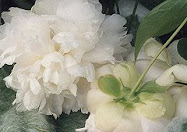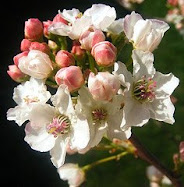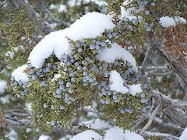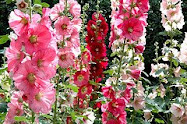 Baby, it's cold outside. Temperatures dug in at the teens and twenties day upon day, the daytime high temperature as this is written predicted to ascend only to 17 degrees. And the snow just keeps coming, heavy-laden fronts of pewter-grey cloud banks following one upon another with payloads of snow, snow, snow. The newspaper weather map shows Michigan's mitten tinted purple for days when snow is forecast, and the mitten map is purple for every day this week, next week also. In the garden, the snow banks are now up to my hips, everything buried in white drifts.
Baby, it's cold outside. Temperatures dug in at the teens and twenties day upon day, the daytime high temperature as this is written predicted to ascend only to 17 degrees. And the snow just keeps coming, heavy-laden fronts of pewter-grey cloud banks following one upon another with payloads of snow, snow, snow. The newspaper weather map shows Michigan's mitten tinted purple for days when snow is forecast, and the mitten map is purple for every day this week, next week also. In the garden, the snow banks are now up to my hips, everything buried in white drifts.One advantage for the garden of the daily-restocked, pristine snow is that it reveals what the deer are up to, which constituents of the garden they take a particular interest in and thus which ones likely are most at risk from deer foraging. In this village bordered on all sides by national park wetlands, dunes and forests, small herds of six to twelve deer reliably walk through every morning and night, going east at sunrise, west at twilight, and spending the wee hours between midnight and dawn fanning out to graze for leaves, bark and berries. It is said a deer spends its lifetime following ancestral trails, never moving more than a mile from where it was born. Put up houses, barns, plant crops or gardens, pave roads, move in human inhabitants, it doesn't faze the deer or change their instinctual, ritual trailways, even if those now carry the herd through village backyards or right down Front Street, past the post office and grocer.
First thing in the morning a few days ago, what greeted the eye in the backyard was an area completely and precisely dug out of the three feet of snow around a bird feeder normally filled with sunflower seeds. Since late fall, when most of the birds except crows pretty much disappeared from my windy neighborhood, I stopped stocking the bird feeder after realizing it was drawing the deer into the yard, where they would not only scarf up it's scant two cups of sunflower seeds, but then proceed to nibble on every plant in the immediate vicinity. Deer must rival elephants in their memory, however, as the fresh hollow around the bird feeder showed, returning to scavenge where they previously struck lucky, even for so small a payoff as a few handfuls of sunflower seed.
On this morning, the still-empty bird feeder was left snuggled under yesterday's new snowfall, and the deer tracks instead carved furrows across the backyard to the lilac bushes, then along the side of the house to the pear tree in the front yard, on to the tips of rosebushes sticking up above the snow, then finishing their tour at the young cherry tree on the front easement. Donning boots (pointless when the snow comes up to your hips, but oh well), gloves, hat, scarf, etc., my legs plowing the deer track a little deeper and wider as I climbed and clambered through the snow, an inspection of the trees and shrubs thankfully did not find damage or evidence of deer-inflicted pruning and bark-stripping.
A few weeks back, before the endless snowfall of winter 2008-9 really got up a head of steam, deer-proofing measures were undertaken. Small muslin bags of meat meal and red pepper, a deer odor-repellent, were tied to hang on the rosebushes, young trees, and the shrubs deer like to eat, namely the lilacs, witchhazel and hydrangea. Then for good measure, these plants were sprayed until dripping with a liquid repellent made up of garlic and eggs (available at garden stores as Deer Off, Liquid Fence, etc.), which deer quite sensibly hate the smell and taste of. We had a hard freeze the night after this treatment, so with luck, the spray repellent froze onto the branches where it will continue to make them taste disgusting to the deer until the next thaw.
Oddly enough, the muslin deer bags were gone altogether from the lilac bushes, though still in place on the other shrubs and trees. Perhaps they're on the ground, buried under the snow, but they were tied on close to the center of the lilacs, behind branching limbs, and could not have blown or been slipped off. The deer bags on the roses hung strangely shredded, just their top half and the tie remaining, the contents of the bags and the bottoms ripped away. How did the bags get off the lilacs? How did the bags on the roses get torn apart? Surely not by the deer, who have never disturbed or so much as touched the bags before. One of the mysteries of the winter night in the garden. Maybe it was the coyotes, who often can be heard crying to the moon between midnight and dawn, out on coyote patrol. Maybe they took offense at the blood-meal scent of another species, and promptly showed it whose territory this really was by biting the intruder bags to pieces.
The deer and coyotes are not begrudged their traditional, ancient travel ways and hunting grounds. Beguiling, enthralling to watch, they complement and complete the landscape much more than do the buildings that have been erected on their turf. This time of year, this kind of deep winter unfurling with a fury from the first of December, is simultaneously so beautiful and so dangerous. The deer are welcome to walk through the garden on their familiar route every nighttime, but hopefully discouraged from stopping while there to consume late night snacks.









No comments:
Post a Comment